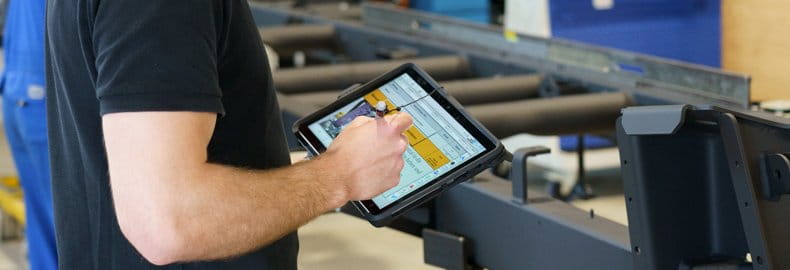Challenge
An innovative manufacturer of wheeled armoured vehicles aspires to become a paperless factory. Since they operate in a heavily regulated industry, extensive documentation is required. Under current processes, this translates into significant effort by the operator (stamping paper documents, printing reports, manual data entry, etc.), as well as increased risk that work instructions for assembly processes are incorrect or out-of-date.
Solution
After switching to digitized production documents, work instructions are automatically updated from the ERP, providing audit trails for revision changes. Work instructions and relevant documentation are displayed on tablets for each worker, and production devices along the assembly line, like smart tools and test equipment, are connected to the system, ensuring quality traceability.
Results
Using digitized work instructions on tablets for each worker, connected to all relevant production devices, the factory realized the following benefits:
- Preparation time savings (>1 hour per order)
- Reduction of rework (-20%)
- Always up-to-date instructions
- Full traceability
The digitization of production documents allowed the manufacturer to continue innovating while maintaining standardized processes and improving production metrics.
How can manufacturing leaders navigate the tension between innovation and standardization to ensure they get full benefits from both?
Reduction of overhead thanks to digitized work instructions
Innovation is exciting – it enables rapid process improvement and redesign, as well as new ways of working. In practice, manufacturing innovation takes the form of automation, technological improvements in machines and materials, enhanced use of data and computing power. All of these advancements can help move operations forward by allowing operators to do more with less, while providing more visibility and measurability. Standardized workflows – including the work instructions and protocols that define those workflows – are integral to ensuring quality.
Any change to a process requires updated work instructions
That means that new production documents must be written and distributed and previous versions must be collected and removed. It’s a time-consuming, error-prone process, and it introduces the risk that outdated work instructions could lead to inconsistent outcomes. These documentation hurdles increase the ‘overhead’ required by each process change, which can stifle innovation and improvement.
Digitization gives workers peace of mind
Innovation can affect more than just processes and procedures – it can also impact people. Digitized production documents facilitate training, learning and working. The flexibility provided by digitized work instructions can reduce the overall time and effort required for training, while still supporting the individual needs of operators.
Consistent Process- and Quality optimization in assembly
When process improvements are easy to implement, they are implemented more often, leading to a culture of continuous improvement. Digitized work instructions enable operators not only to follow along with updated process step, but also to suggest improvements within the work instructions themselves, which can then be quickly and easily incorporated. This two-way flow of knowledge can increase productivity by allowing front-line workers to contribute best practices. Inputs are quickly validated and can be integrated into step-by-step instructions to improve the manufacturing process.
Digitized production documents also enable more data capture, traceability, and quality control than paper documents.
Smart devices and testing equipment can be integrated to ensure quality by only advancing to the next step after the previous one is performed correctly. As an operator works their way through digitized work instructions, information is collected at each step, which results in rich datasets that can be analyzed for process improvements and filed as product life record to be used for audits.
Conclusion
Amidst industry trends and new technology, manufacturers are faced with increasing pressure to grow, adapt, and adopt new ways of working; however, the need for consistent, repeatable processes and high-quality output remains as important as ever. Digitized production documents combine the best of both worlds by enabling innovation while ensuring standardization, allowing manufacturers to move confidently toward the future.
Get in touch with us to learn more


